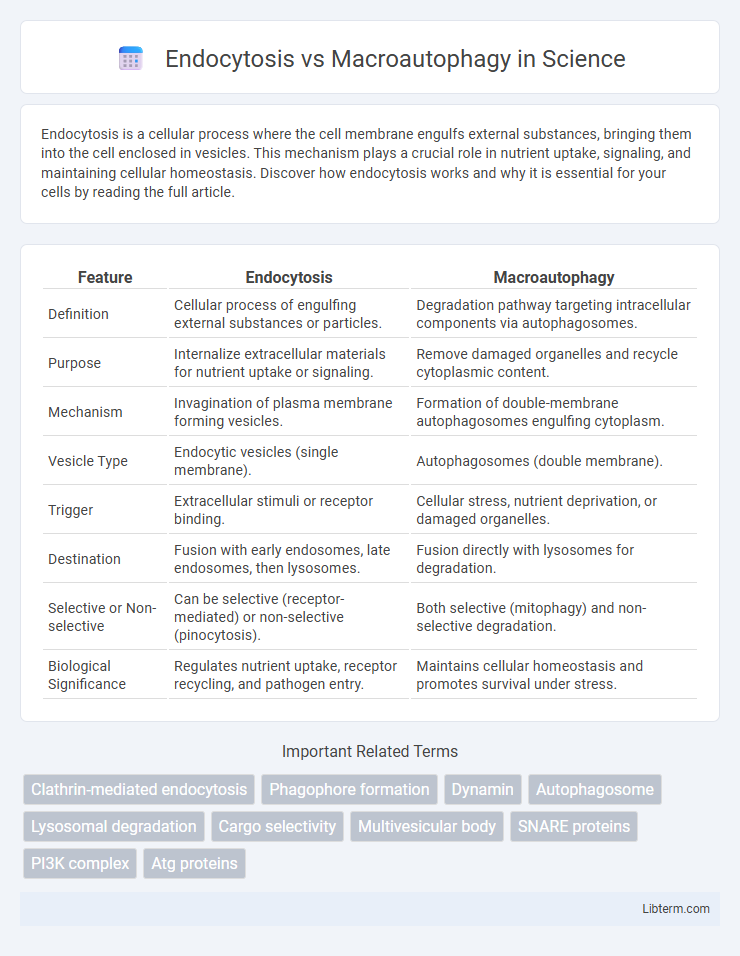Endocytosis is a cellular process where the cell membrane engulfs external substances, bringing them into the cell enclosed in vesicles. This mechanism plays a crucial role in nutrient uptake, signaling, and maintaining cellular homeostasis. Discover how endocytosis works and why it is essential for your cells by reading the full article.
Table of Comparison
| Feature | Endocytosis | Macroautophagy |
|---|---|---|
| Definition | Cellular process of engulfing external substances or particles. | Degradation pathway targeting intracellular components via autophagosomes. |
| Purpose | Internalize extracellular materials for nutrient uptake or signaling. | Remove damaged organelles and recycle cytoplasmic content. |
| Mechanism | Invagination of plasma membrane forming vesicles. | Formation of double-membrane autophagosomes engulfing cytoplasm. |
| Vesicle Type | Endocytic vesicles (single membrane). | Autophagosomes (double membrane). |
| Trigger | Extracellular stimuli or receptor binding. | Cellular stress, nutrient deprivation, or damaged organelles. |
| Destination | Fusion with early endosomes, late endosomes, then lysosomes. | Fusion directly with lysosomes for degradation. |
| Selective or Non-selective | Can be selective (receptor-mediated) or non-selective (pinocytosis). | Both selective (mitophagy) and non-selective degradation. |
| Biological Significance | Regulates nutrient uptake, receptor recycling, and pathogen entry. | Maintains cellular homeostasis and promotes survival under stress. |
Introduction to Cellular Uptake Mechanisms
Cellular uptake mechanisms primarily include endocytosis and macroautophagy, which serve distinct yet complementary roles in internalizing extracellular material and degrading intracellular components, respectively. Endocytosis encompasses processes like phagocytosis, pinocytosis, and receptor-mediated endocytosis, enabling cells to internalize nutrients, pathogens, and signaling molecules. Macroautophagy, characterized by the formation of double-membrane autophagosomes, targets damaged organelles and protein aggregates for lysosomal degradation, maintaining cellular homeostasis and stress response.
Defining Endocytosis: Pathways and Processes
Endocytosis is a cellular process involving the internalization of extracellular materials through multiple pathways, including clathrin-mediated endocytosis, caveolae-dependent endocytosis, and macropinocytosis. These pathways facilitate the selective uptake of nutrients, signaling molecules, and pathogens into vesicles that fuse with early endosomes for sorting and trafficking. Contrastingly, macroautophagy primarily targets intracellular components for degradation and recycling within autophagosomes, highlighting distinct roles in cellular homeostasis.
Understanding Macroautophagy: Mechanisms and Functions
Macroautophagy is a cellular degradation process that engulfs cytoplasmic components within double-membrane vesicles called autophagosomes, which fuse with lysosomes for content breakdown. This mechanism maintains cellular homeostasis by recycling damaged organelles and proteins, supporting energy balance and stress responses. Unlike endocytosis, which internalizes extracellular materials, macroautophagy specifically targets intracellular components for degradation and renewal.
Key Molecular Players in Endocytosis and Macroautophagy
Endocytosis primarily involves key molecular players such as clathrin, dynamin, and adaptor protein complexes (AP2), which facilitate vesicle formation and scission from the plasma membrane. Macroautophagy relies on core autophagy-related (ATG) proteins like ULK1 complex, Beclin-1, and LC3, orchestrating autophagosome formation and maturation to degrade cytoplasmic cargo. Both processes coordinate distinct yet overlapping molecular machineries critical for cellular trafficking and homeostasis.
Major Differences Between Endocytosis and Macroautophagy
Endocytosis primarily involves the cellular uptake of extracellular materials through vesicle formation, whereas macroautophagy targets the degradation of intracellular components by sequestering them into autophagosomes that fuse with lysosomes. Endocytosis is driven by membrane invagination and vesicle trafficking from the plasma membrane, while macroautophagy originates from the formation of double-membrane structures within the cytoplasm. The key difference lies in their functional roles: endocytosis regulates nutrient uptake and receptor internalization, whereas macroautophagy maintains cellular homeostasis by recycling damaged organelles and protein aggregates.
Overlapping Roles and Interplay in Cellular Homeostasis
Endocytosis and macroautophagy share overlapping roles in cellular homeostasis by coordinating the degradation and recycling of cellular components to maintain nutrient balance and remove damaged organelles. Both pathways converge on the lysosome, where endocytic vesicles and autophagosomes deliver cargo for degradation, highlighting their interplay in regulating membrane trafficking and cellular quality control. This functional synergy ensures efficient turnover of macromolecules and supports cellular adaptation to stress and nutrient availability.
Endocytosis in Health and Disease
Endocytosis is a critical cellular process responsible for internalizing extracellular molecules, nutrients, and membrane receptors, playing a vital role in maintaining cellular homeostasis and signaling. Disruptions in endocytosis are linked to various diseases, including neurodegenerative disorders like Alzheimer's disease, where defective clearance of amyloid-beta peptides occurs, and cancer, where altered receptor-mediated endocytosis affects cell proliferation and survival. Understanding the molecular mechanisms regulating endocytosis offers potential therapeutic targets for treating conditions associated with impaired cellular uptake and trafficking.
Macroautophagy in Health and Disease
Macroautophagy is a critical cellular process that degrades and recycles cytoplasmic components, maintaining cellular homeostasis and energy balance. Dysregulation of macroautophagy is linked to various diseases, including neurodegenerative disorders like Parkinson's and Alzheimer's, as well as cancer and infectious diseases. Enhancing macroautophagy pathways offers therapeutic potential by clearing damaged organelles and protein aggregates, thereby promoting cell survival and function.
Research Techniques for Studying Endocytosis Vs. Macroautophagy
Fluorescence microscopy and live-cell imaging are essential research techniques for studying endocytosis, enabling visualization of vesicle formation and trafficking using labeled ligands or membrane markers. In contrast, macroautophagy studies typically employ electron microscopy for ultrastructural analysis, along with assays measuring LC3 lipidation and p62 degradation to monitor autophagosome formation and autophagic flux. Genetic manipulation methods such as siRNA knockdown or CRISPR-Cas9 gene editing are applied in both fields to dissect the roles of specific proteins like clathrin in endocytosis and ATG proteins in macroautophagy.
Future Directions and Therapeutic Implications
Emerging research highlights the potential of targeting endocytosis and macroautophagy pathways to enhance drug delivery and modulate cellular homeostasis in neurodegenerative diseases. Advances in understanding the molecular mechanisms governing selective autophagy and endosomal trafficking can lead to the development of novel therapeutics aimed at mitigating protein aggregation and cellular stress. Future directions emphasize integrating these pathways with precision medicine approaches to improve outcomes in cancer, metabolic disorders, and infectious diseases.
Endocytosis Infographic

 libterm.com
libterm.com